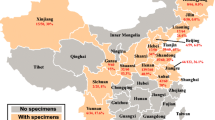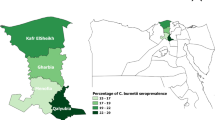Abstract
Since Coxiella burnetii, the causative agent of Q fever, is often transmitted from goats and sheep to humans through aerosols, we examined the sera from 168 persons involved in goat breeding in the Centre region of France and 40 members of veterinary and medical staff from the same region for the presence of antibodies against C. burnetii. An immunofluorescence assay was used to detect the presence of antibodies of the IgG isotope against epitopes from phase II of C. burnetii, which are the first antibodies to appear in infected people, and from phase I, which reflect more chronic stages of the infection. Our serological survey showed that most of the tested sera were positive for C. burnetii markers, indicating at least an encounter with the bacterium. In the overall population of 208 subjects, 71% of the sera had antibodies against phase II epitopes (titres ⩾ 1:40). Among the goat farmers and their immediate families, 78% had antibodies against phase II and 33% against phase I (titres ⩾ 1:40). Considering only high titres (⩾ 1:320), though, only 37% of the farmers had antibodies against phase II and 15% against phase 1. Only 3 out of 12 veterinarians working in the field had high titres of antibodies against phase II and phase I, while none of 28 members of veterinary and medical laboratories had significant levels of antibodies. These results emphasize the need for closer surveillance of populations at risk for Q fever, to prevent the infection by C. burnetii from reaching chronic stages of the disease.
Similar content being viewed by others
References
Dumler JS, Walker DH. Diagnostic tests for Rocky Mountain spotted fever and other rickettsial diseases. Dermatol Clin 1994; 12: 25–36.
Reimer LG. Q fever. Clin Microbiol Rev 1993; 6: 193–198.
Rehacek J. Rickettsiae and their ecology in the Alpine region. Acta Virol 1993; 37: 290–301.
Sanzo JM, Garcia Calabuig MA, et al. Q fever: Prevalence of antibodies to Coxiella burnetii in the Basque country. Int J Epidemiol 1993; 22: 1183–1188.
Brouqui P, Dupont HT, Drancourt M, et al. Chronic Q fever. Ninety-two cases from France, including 27 cases without endocarditis. Arch Intern Med 1993; 153: 642–648.
Ellis ME, Smith CC, Moffat MAJ. Chronic or fatal Q fever infection: A review of 16 patients seen in northeast Scotland. Q J Med New Ser 1982; 205: 54–66.
Turck WPG, Howitt G, Turnberg LA, et al. Chronic Q fever. Q J Med New Ser 1976; 45: 193–217.
Hackstadt T, Peacock MG, Hitchcock PJ, Cole RL. Lipopolysaccharide variation in Coxiella burnetii: Intrastrain heterogeneity in structure and antigenicity. Infect Immun 1985; 48: 359–365.
Hunt JG, Field PR, Murphy AM. Immunoglobulin responses to Coxiella burnetii (Q fever): Single-serum diagnosis of acute infection, using an immunofluorescence technique. Infet Immun 1983; 39: 977–981.
Peacock MG, Philip RN, Williams JC, Faulkner RS. Serological evaluation of Q fever in humans: Enhanced phase I titers of immunoglobulins G and A are diagnostic for Q-fever endocardits. Infect Immun 1983; 41: 1089–1098.
Tobin MJ, Cahill N, Gearty G, et al. Q fever endocarditis. Am J Med 1982; 72: 396–400.
Bernard KW, Parham GL, Winkler WG, Helmick CG. Q fever control Measures: Recommendations for research facilities using sheep. Infect Control 1982; 3: 461–465.
Philip RN, Casper EA, Ormsbee RA, et al. Microimmunofluorescence test for the serological study of Rocky Mountain spotted fever and typhus. J Clin Microbiol 1976; 3: 51–61.
Wilson HG, Neilson GH, Galea EG, et al. Q fever endocarditis in Queensland. Circulation 1976; 53: 680–684.
Baroqui P, Dumler JS, Raoult D. Immunohistologic demonstration of Coxiella burnetii in the valves of patients with Q fever endocarditis. Am J Med 1994; 97: 452–458.
Smith DL, Ayres JG, Blair I, et al. A large Q fever outbreak in the West Midlands: Clinical aspects. Respir Med 1993: 87: 509–516.
Macellaro A, Akesson A, Norlander L. A survey of Q-fever in Sweden. Eur J Epidemiol 1993; 9: 213–216.
Morita C, Katsuyama J, Yanase T, et al. Seroepidemiological survey of Coxiella Burnetii in domestic cats in Japan. Microbiol Immunol 1994; 38: 1001–1003.
Pinsky RL, Fishbein DB, Greene CR, Gensheimer KF. An outbreak of cat-associated Q fever in the United States. J Infect Dis 1991; 164: 202–204.
Thibon M, Villiers V, Souque P. Q fever in France. About 32 cases of C. burnetii endocarditis detected and observed from 1987 to 1991. 3rd Western Pacific Congress On Chemotherapy and Infectious Diseases. Bali, Indonesia. 1992; 270 [abstract].
Racult D, Stein A. Q fever during pregnancy — a risk for women, fetuses, and obstetricians [letter]. N Engl J Med 1994; 330: 371.
Author information
Authors and Affiliations
Corresponding author
Rights and permissions
About this article
Cite this article
Thibon, M., Villiers, V., Souque, P. et al. High incidence of Coxiella burnetii markers in a rural population in France. Eur J Epidemiol 12, 509–513 (1996). https://doi.org/10.1007/BF00144005
Accepted:
Issue Date:
DOI: https://doi.org/10.1007/BF00144005




